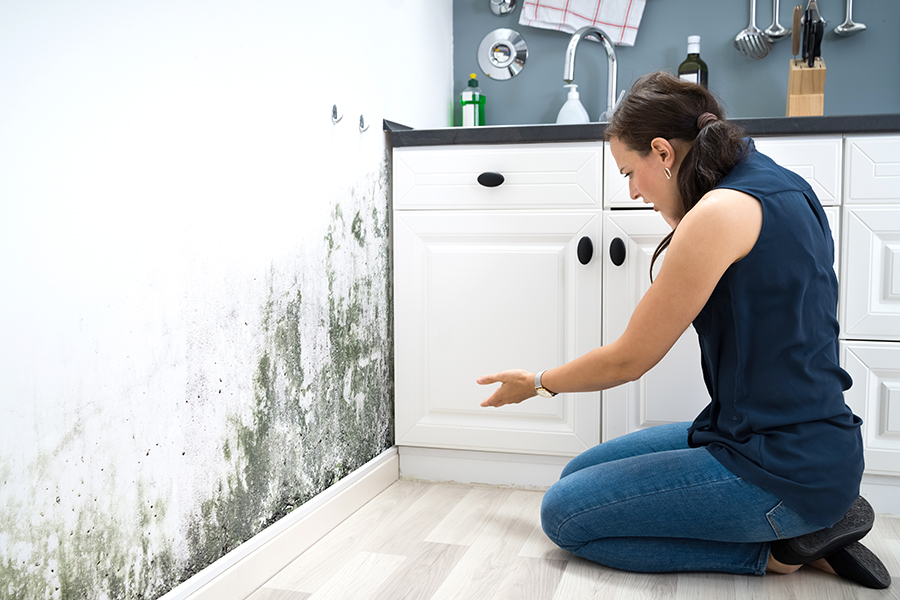Discovering mold in your home can seem like a catastrophe. You must now locate the source of the moisture, assess the extent of the damage, document the damage, and find a way to clear out the mold, whether doing it yourself or hiring an expert in mold removal. It’s a big task that must be done in a timely manner.
But who pays for mold remediation? Are you on the hook to cover it out of pocket or will your home insurance company cover the costs? This is an important distinction to understand because it may determine your course of action.
Continue reading to find out more information on mold damage and homeowners insurance coverage.
When Does Homeowners Insurance Cover Mold?
Whether or not your mold damage is eligible to be covered by your home insurance policy largely depends on the cause of the mold. If it appears due to a sudden incident that is a covered peril such as a water heater burst pipe, or firehose damage after a covered fire, then your standard homeowner’s insurance policy should cover the mold damage claim. But if you attempt to file a claim for mold damage that has been forming from a dripping water leak for some time or discover mold in ceiling tiles or walls and you’re unsure of how long it has been there, your insurance claim will likely be denied.
The basic premise is this: Mold resulting from a covered peril is covered, mold resulting as a claim in itself, is typically not covered under a standard policy.
Mold Claims Covered by Insurance
Accidental water damage in your home can cause mold. Mold can grow and develop within 24-48 hours after water exposure. Therefore, any type of water damage in your home can result in mold damage. Even if you are quick to act in trying to prevent mold from growing, oftentimes it is already too late or impossible to dry out damaged parts of the home quickly enough to prevent all mold or mildew.
There are several water sources in your home that can result in mold damage if a sudden event occurs. For instance:
Leaking Appliances
Home appliances such as dishwashers, refrigerators, washing machines, and toilets all use water to do their jobs. But what happens when one of these appliances malfunctions and suddenly experiences a large water leak or overflow? Mold can develop quickly. In many cases, home insurance will pay to remove mold and replace walls or flooring that have been irreparably damaged by mold. Though, they often will not replace the appliance that caused the damage.
Burst Pipes
Do you live in an area that freezes? Sometimes frozen water can cause a pipe to suddenly burst and causes mold to grow on floors and walls. This is especially an issue in areas of the country that do not normally experience freezes and therefore materials (and homeowners) are not freeze-prepared. Your homeowner’s insurance policy most likely will pay to replace burst pipes and the damage caused, including mold, that occurs from these unexpected events.
Extinguished Fire
If your home experienced a large fire that required water to extinguish, then you are already likely to file a claim for the fire damage, but what about water damage that occurred to areas of the home that were not damaged by the fire itself? Your home insurance policy should cover all water damage sustained from putting out the covered fire claim.
Mold Claims Not Covered by Insurance
Unfortunately, not all water events that cause mold damage are covered by insurance.
Negligence
Sometimes having a small drip under a faucet doesn’t seem like a huge cause for concern, but if left long enough, mold can develop under the cabinet. Similarly, if windows aren’t sealed properly and water leaks in, the moisture can mildew. Events such as this, where mold forms due to lack of speedy repair, are not covered by insurance.
Water Back Up
Having a sump pump failure or water backup can cause significant water damage if not swiftly resolved and unfortunately, most standard insurance will not cover water or mold damage caused by sewer lines unless it is explicitly stated in your policy.
Flood
All homeowners in a flood plain must purchase separate flood insurance from a standard homeowners insurance policy. This coverage may be offered through your same insurance company but it is backed by the NFIP, therefore your standard policy will not cover mold damage caused by flooding. Though your flood insurance should cover mold if you carry it.
Filing a Mold Claim
If you need to file a mold claim, it must be done quickly because mold forms quickly. If you experience water damage that can cause mold, the first important step is to stop further damage by plugging up a leak or shutting off water access. Next, thoroughly document the damage. This includes taking pictures, and videos, and making extensive lists of everything that was damaged with proof of value.
Once you have the documentation handy, you can take action to begin cleaning and drying the area to prevent further damage, it is important not to make major repairs before your claim is filed but you can do what you need to prevent mold and mildew such as tearing up carpet or wet drywall. Keep all receipts for reimbursement.
Finally, file your claim as quickly as possible. Ensuring that your claim is in the hands of an experienced agent immediately helps you to know what steps to take and what advice to follow to ensure the least amount of damage as is possible.
Finding a Mold Endorsement
Does it concern you that your current policy may not cover all mold damage that could occur in your home? If so, it may be possible to secure a mold endorsement attached to your homeowner’s insurance policy. These may include sump pump failure, water backup coverage, and perhaps hidden water damage coverage. Not all insurance companies offer these endorsements but if you would like to try to find coverage, our team at Independent Insurance Brokers Arizona can help.
Call us today to discuss your concerns and hear about your available mold insurance options.

